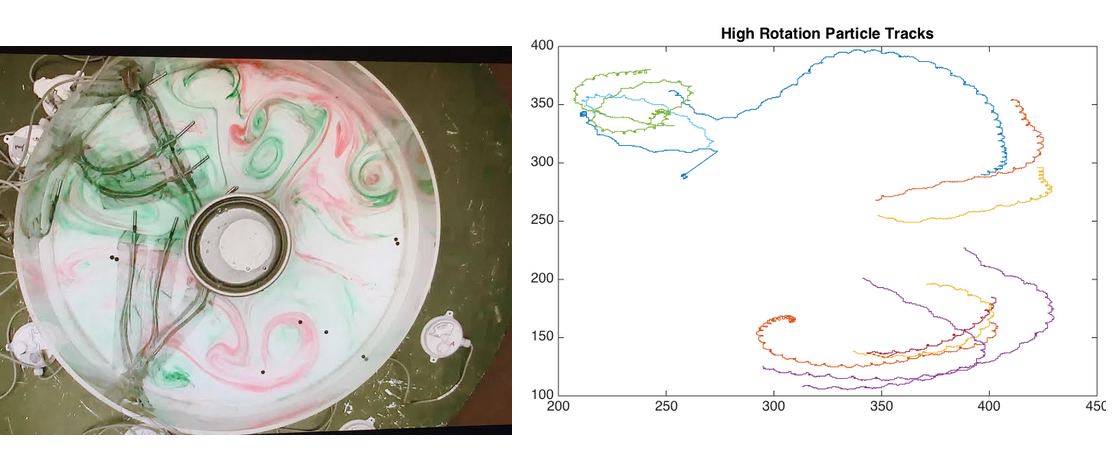Hi! We're Elizabeth, Elizabeth and Katrina, and here's our write-up of the midlatitude eddy circulation portion of our general circulation project.
Introduction
Source: http://visibleearth.nasa.gov/view.php?id=56236
The midlatitude eddy circulation, which we can observe surrounding the pole in the satellite image above, is important for heat transport in the atmosphere. Eddies occur at higher latitudes than the Hadley Cells and as estimates in the plot below show, are responsible for most of the heat transport required by the differential heating of the Earth. Once again we used a tank experiment and atmospheric data to study these eddies. Eddies occur in the midlatitudes, where Earth's rotation is more significant. Thus, to mimic eddies in our tank experiment, we used a high rotation rate and temperature gradient. To study eddies in the atmosphere, we used atmospheric data to study the heat transport involved in the midlatitude eddies.
Source: "Atmosphere, Ocean, and Climate Dynamics: An Introductory Text" by John Marshall & Alan Plumb (2007).
From the figure above, detailing heat transport by latitude, heat transport is at a maximum near 40ºN and S, where eddies occur. We integrate the zonally averaged heat flux due to eddies, to find the net poleward heat flux using the following equation,
where a is the Earth’s radius, is the latitude, cp is the specific heat, g is gravity, and is the zonal average of , with v referring to meridional wind and T referring to temperature. Here, is the total heat flux and is the monthly mean transport. Thus, is the meridional heat flux due to transient eddies; using this equation we will compare its result to what the figure above predicts.
Atmospheric Data
We can notice a couple interesting things from these plots. In the January when the Northern Hemisphere is experiencing winter, we see two clear maximums of Northward heat flux. These could be because the temperature gradient is strongest during the winter. The maximums are located on coasts where there are strong land-sea interactions. The combination of the stronger gradient and land-sea interaction could result in more synoptic scale storms and more eddies, resulting in stronger heat flux in those regions. In July when the Northern Hemisphere is experiencing summer, we observe that the northward heat flux is stronger overall in the Northern Hemisphere as well as more uniform. In both January and July, we see strong southward heat flux in the Southern Hemisphere.
We next plotted the zonally averaged transient heat flux, averaged over the longitudes following:
These two plots again show poleward heat flux in both hemispheres. Both plots also show two maximums of heat flux, one at a higher and one at a lower altitude. Maximums in heat flux can be caused by either differences in velocity or in temperature. Higher in the atmosphere, the heat flux maximum could be driven by the strong velocity difference around the fast polar jet. Lower in the atmosphere, the heat flux maximum could be caused by the difference in temperature between the land and ocean.
Finally, we vertically integrate the zonally averaged transient heat flux and multiply by some constants to find the zonally and vertically integrated transient sensible energy flux using:
The maximum energy flux away is approximately 1PW and found around 40ºN and 40ºS because the eddy heat transport carries heat from the midlatitudes to the poles. The maximum energy flux from the atmosphere is actually about 4 PW in both North and South directions from around 40ºN and 40ºS. There is a discrepancy because we only calculated the sensible heat energy flux, neglecting the contributions from latent heat energy and potential energy that contribute to the 4PW plot.
Tank Experiment
Using a high rotation rate (10 rotations per minute) to simulate the much higher Coriolis parameters at near-polar latitudes, we set up a tank experiment to observe eddy heat transport. As in the Hadley experiment, a metal bucket of ice was placed at the center of a rotating circular tank. However, due to the high rotation rate, dots placed on the surface of the water were observed to follow the shape of smaller-scale eddy currents, rather than rotating around the tank. Similarly, red and green dye placed in the tank highlighted small disturbances and rotating cells.


